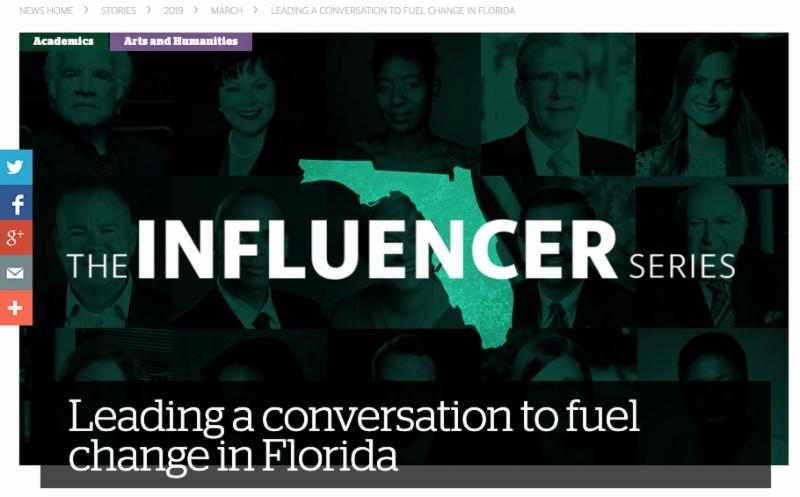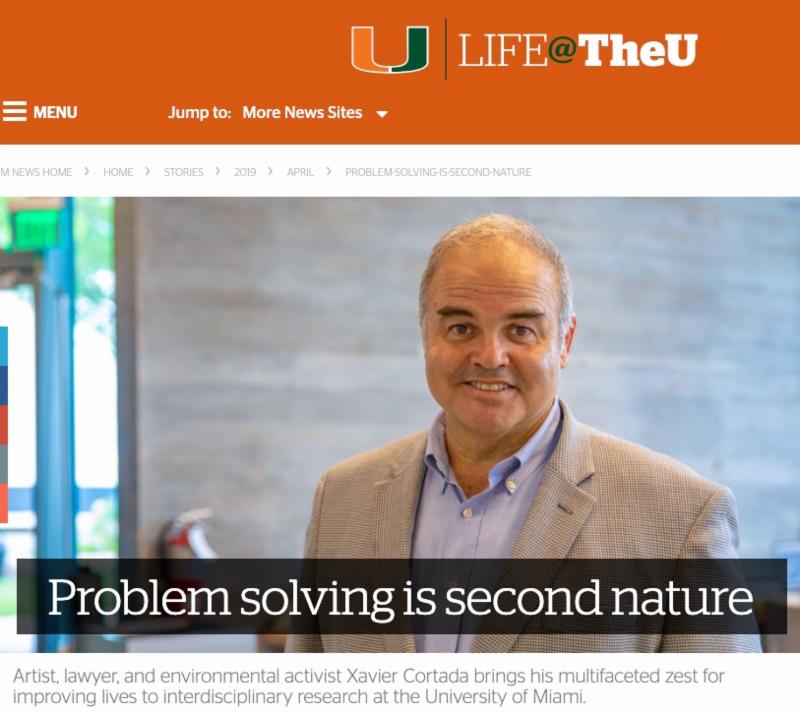Home » Newsletters » 2019 News » April 2019 – Cortada joins University of Miami faculty as Professor of Practice
The Miami Herald, el Nuevo Herald and the Bradenton Herald have again assembled a panel of 50 influential Floridians to provide insight and views on critical issues to Florida’s future. Click here to continue reading.
AP: ‘Underwater’ homeowners group promotes climate change action
By Jennifer Kay | AP
March 29
PINECREST, Fla. — The “Underwater Homeowners Association” sounds like a sad joke about the future of real estate in flood-prone Miami.
It’s actually an earnest effort to turn neighbors into climate-change advocates, block-by-block.
Starting in his affluent suburb of Pinecrest, artist Xavier Cortada hopes his concept will spread, helping people nationwide understand that melting polar ice is no abstract threat.
Cortada repurposes “for sale” signs, painting partially-submerged numbers that announce exactly how many feet above sea level each property is, for people to plant in their front yards. A growing number of members have signed on at underwaterhoa.org since Cortada launched the idea in December.
Click here to continue reading The Washington Post article.
Problem solving is second nature
Xavier Cortada first set foot on the University of Miami campus as a young boy, when his father and uncle were exhibiting their work at the annual Beaux Arts Festival of Art.
“The art made a huge impression, of course,” Cortada said recently, at the Shalala Student Center where his “Flight of the Ibis” tapestry graces the wall behind the grand staircase. “But, so did the duck eggs I saw along the canal near the Lowe Art Museum. That piqued my lifelong fascination with both art and science.”
Four decades after that visit, Cortada, a triple alumnus who has used art to advocate for social justice, raise environmental consciousness, celebrate scientific discovery, and build bridges of understanding around the world, has returned to his alma master to help expand UM’s burgeoning culture of interdisciplinary research as a professor of professional practice.
His primary appointment is in the Department of Art and Art History in the College of Arts and Sciences, but he’s already working with the Rosenstiel School of Marine and Atmospheric Science, the Miami Business School, and the UM Laboratory for Integrative Knowledge (U-LINK) to harness the power of what he calls “engaged social practice.” That, he said, mandates working with others, finding new ways of thinking together, and creating new knowledge.
“It is hard to build new knowledge alone,” Cortada said, a few days before the Miami Herald named him and UM President Julio Frenk as one of its 50 Florida Influencers. “For example, when you combine psychology and biology, you create a new area of research: psychobiology. If you advance or ‘dance’ with others, you get more dynamic results, you can move forward faster.”
Jeffrey Duerk, executive vice president for academic affairs and provost, said Cortada’s vast multidisciplinary experience and world view make him an ideal person to advance the University’s growing mission to nurture the kind of interdisciplinary collaborations needed to tackle society’s most complex problems.
“That is an essential component of the University Roadmap,” Duerk said, “and Xavier Cortada is an exciting new faculty appointment that moves us toward this goal. We’re already seeing the impact of his extraordinary abilities in our exploratory meetings with faculty, students, and the research community.”
Professor Tomas Lopez, chair of the Department of Art and Art History, said that with a focus on “integrating art, social practice, community relations, and science and environmental issues,” Cortada is a great addition to the department.
Just three months on the faculty and with secondary appointments in architecture, business, communication, law, and science, Cortada said he’s already found a lot of enthusiasm for collaboration, and has reached out first to those who already expressed an interest in blurring the lines. At the Rosenstiel School, he’s working with scientists in the SUSTAIN lab, the tank that simulates hurricane winds and waves, to “paint pictures” that visually represent research data on hurricane activity.
He’s also collaborating with faculty in the Miami Business School on ways they can encourage the next generation of business leaders to incorporate sustainable practices in their operations. As a first step, he secured the donation of 100 salt-tolerant plants from the Frost Science Museum for business students to plant in low-lying areas of Miami. Dean John Quelch said Cortada’s “Four Seasons” prints hanging in the foyer of Storer Auditorium “have brought life and meaning to our new emphasis on the arts and on sustainability.”
And Cortada met informally with Susan Morgan, associate provost for research and co-director of U-LINK, to explore ideas for using U-LINK grants to position UM as a leader in addressing one of the most cataclysmic consequences of climate change: the migration of millions of people who, according to a World Bank report, will flee their homelands within 50 years to escape rising seas, crop failures, and water scarcities.
“Nobody’s looking at the Caribbean basin and the fact that, as sea levels rise, there will be a large people migration, probably first to Miami, but eventually to the rest of the United States,” Cortada said. “My hope is that the University of Miami can bring equity to that discussion through collaborative research and dialogue. For example, in the area of housing, we could use the School of Communication’s big data visualizations to understand the trends, and then help community leaders plan for this migration.”
As Cortada notes, art is his medium, and science his muse, but solving problems is his second nature. His passion for and success at merging all three pursuits was encouraged and honed as an undergrad at UM, where he participated in cardiology research at the Veterans Affairs Medical Center, was speaker of the senate in Student Government, and served on the University’s Board of Trustees, Council of International Students and Organizations, and as vice president of the biology club.
A member of the Iron Arrow, Mortar Board, and Omicron Delta Kappa honor societies, he went on to earn a master’s degree in public administration from the business school, and a juris doctor from the School of Law, where he raised awareness about social inequality, gang and gun violence, drug issues, and began building bridges through community activism and participatory art projects.
Countless accolades and public art installations later—for peace in Cyprus and Northern Ireland, child welfare in South America, juvenile justice in Miami-Dade County, International AIDS Conferences in Geneva and South Africa, and minority homeownership at the White House —he turned his considerable energy to raising global awareness about climate change and sea-level rise through a number of public art installations. Among them: “Underwater HOA,” in partnership with the Abess Center for Ecosystem Science and Policy, “Antarctic Ice Paintings,” and “Longitudinal Installation,” which was timed with each seasonal equinox and solstice.
As the principal investigator on sponsored grants from the National Science Foundation and the New York Foundation for the Arts, his “90N/90S” art installations on the North and South poles will track moving ice sheets for the next 150,000 years and raise awareness for global climate change.
Now he is excited about the opportunity to help a new generation of scholars and students do what he said the University did for him—shatter assumptions and find the commonalities between disciplines that help people understand the world, and advance human knowledge.
“I am self-directed to find the convergence, and I learned that ability at the U,” Cortada said. “That’s what makes coming back here so exciting. Every corner I turn on campus I see places that informed and transformed me as a student. Places I know very well, such as SA126 in the Cox Science Building. That lecture hall means everything to me. As a kid from Miami High School, I came in and I thrived. I hope to inspire today’s students in the same way.”






